ㅤ
ㅤ
ㅤ
This year, our Christmas campaign, Connected at Christmas, celebrates the connections that matter most, both within our group and with the people we serve through our communication solutions.
Our Christmas card brings the concept to life through illustrations by Shoreditch Sketcher Phil Dean, Founder of our creative agency, Studio Certain. Inspired by sketches of our UK sites in Tottenham, Central London and Warrington, and enriched with subtle festive touches and real imagery of our people, the design reflects the spirit of togetherness at MBA Group.
As a family-run business built on relationships, connection is at the heart of everything we do. The relationships we build with our colleagues, clients, their customers and our partners shape how we work, how we grow and the value we create together.
From all of us at MBA, we wish you a very Merry Christmas and a wonderful festive season spent with the people you care about most.
ㅤ
If your organisation is preparing for the next chapter in communication, we’re here to help you make it happen.
ㅤ
ㅤ
At MBA, our strength has always come from the relationships we’ve built and maintained with our clients from over 40 years of transforming communications.
As we continue to grow rapidly, welcoming new clients while supporting long-standing ones, we’re constantly working to optimise a faster, more efficient onboarding experience. Migrations must be seamless, communication must remain accurate, compliant, and secure, and expectations for speed have never been higher.
We’ve already invested heavily in streamlining our processes through development work, and while that has delivered strong progress, we’ve always recognised the need for further evolution in areas still reliant on traditional coding. With the intelligence and flexibility of AI, we know we can achieve more, and as a service provider, it’s imperative that we explore those possibilities. So when AWS recommended Devoteam as a partner to help us understand how AI could enhance our onboarding workflow, we seized the opportunity to take our approach further.
Instead of asking Devoteam to solve only the parts we hadn’t yet addressed, we gave them the entire challenge. We wanted a clear, unbiased view of what AI could deliver when applied end-to-end.
ㅤ
Reimagining a Core MBA Process
ㅤ
Onboarding a new client at scale is a detailed, highly specialised piece of work. Traditionally, our expert BA team analyses and transforms thousands of customer communication templates, each one needing to align with brand guidelines, regulatory requirements and the client’s own expectations.
It’s a process that demands care, consistency and deep domain expertise.
By stepping back and examining this workflow through the lens of AI, we identified several opportunities to improve:
- Speeding up onboarding from months to days
- Ensuring greater consistency across thousands of documents
- Freeing our BA team from repetitive manual extraction
- Increasing the time they can spend on design, quality and innovation
- Delivering a noticeably faster, more modern onboarding experience for clients
We saw AI as an opportunity that would empower our analyst teams and in turn, deliver the best customer experience for our clients.
ㅤ
Partnering with Devoteam to Explore What AI Could Deliver
ㅤ
Working with Devoteam, an AWS Premier Partner, we launched a Generative AI-powered Proof of Value (PoV) aimed at showing what an AI-supported onboarding process could look like at MBA.
The PoV focused on analysing PDF templates and transforming them into a structured, highly organised library of reusable components.
Key capabilities developed included:
- Paragraph and element analysis: Recognising headers, footers, signatures and data fields
- Brand capture: Identifying fonts, colours and layouts so branding stays precise
- Image cataloguing: Extracting imagery, placements and dimensions
- Variable indexing: Detecting placeholders and embedded variables
- Master template detection: Understanding the core structure behind diverse document sets
These were areas that would traditionally take our team weeks of manual scrutiny, but AI was proving to accomplish many of them in minutes.
ㅤ
A Fast, Collaborative Delivery Approach
ㅤ
Devoteam worked closely with our BA team using their ADAPT framework, progressing through tight, focused sprints:
- Discovery & scoping: Clarifying objectives and what success would look like
- Rapid prototyping: Building and refining GenAI models based on real MBA data
- Testing & validation: Comparing the AI’s output with results our BA team produced previously
- Roadmapping: Outlining how MBA could scale the solution into production
This collaboration kept the work grounded in reality. We weren’t relying on theoretical AI promises, we were measuring real, tangible improvements against an already complex process.
ㅤ
The Impact: Faster, Smarter and More Accurate
ㅤ
The impact was significant. Work that once took months could now be completed in a matter of hours, accuracy improved with far fewer manual errors, and our BA team were able to redirect their time toward more strategic, value-driven work such as auditing, innovation and quality assurance.
For us, it validated a belief we had going into the project: the future of onboarding at MBA isn’t AI or code, it’s the intelligent combination of both.
ㅤ
Where We Go from Here
ㅤ
The success of testing how AI efficiency can improve our onboarding processes has unlocked a new phase for MBA.
We’re now shaping these learnings into a roadmap, where we’ll introduce asynchronous parallel processing to increase speed even further, integrate AI outputs directly into our wider document management ecosystem, and blend Devoteam’s AI models with our own codebase to build a powerful, efficient hybrid solution.
And while the PoV delivered strong results, we fully expect that we’ll engage with Devoteam again as we continue to expand our AI capability. The collaboration has already shown what’s possible, and we know there is more value to unlock.
By embracing the best of both AI and engineering, we’re continuing to move forward alongside technology developments at MBA, delivering our promise of simply powerful communication, and redefining what enterprise-level onboarding can look like.
ㅤ
“At MBA Group, we’re proud to be using Artificial Intelligence to drive efficiency, innovation, and value for our people and clients. Partnering with Devoteam on our Generative AI initiative has been a key step in that journey, helping us streamline client onboarding, accelerate delivery, and empower our teams to focus on higher-value work. This Proof of Value demonstrates our commitment to using AI that delivers real benefits and strengthens MBA’s position as a leader in intelligent, transformative customer communications.”
- Phil Coleman, Head of Products & Projects, MBA Group
ㅤ
Our Evolution Timeline
ㅤ
ㅤ
For over 40 years, MBA has been at the heart of how organisations communicate, evolving from traditional print roots into a leader in secure, data-driven, omni-channel communication.
This timeline, launched at our 40th celebration earlier this year, highlights the milestones, innovations, and moments that shaped MBA into the powerhouse it is today. It showcases how the business has consistently adapted to new technologies, new expectations, and new ways of connecting, always with our people at the heart.
As we wrap up the year and look towards 2026 and beyond, the story continues. Our channels are expanding, our partnerships are growing, and our investment in technology and AI is accelerating. The same spirit of innovation that defined our past is driving our future, helping us build smarter, more seamless, and more personalised ways for organisations to communicate in the years ahead.
ㅤ
If your organisation is preparing for the next chapter in communication, we’re here to help you make it happen.
ㅤ
When MBA Group launched its apprenticeship programme in December 2023, we set out to tackle the industry’s skills gap head-on. Fast forward to 2025, and our apprentices are already driving real change, bringing fresh energy to teams and delivering on major projects.
But here’s where it gets exciting: one of our own apprentices, Hannah Hall, spotted an opportunity through a university assignment. Her project? A bold new identity for the apprenticeship programme itself.
The work was so impressive, packed with insight, research, and standout design, that we didn’t just grade it. We brought it to life. Next Step is now our official apprenticeship brand, rolling out across welcome brochures, recruitment materials, and beyond.
This is how a university assignment became the face of MBA’s talent strategy and proof that great ideas can come from anywhere.
ㅤ
The Opportunity
ㅤ
Our apprenticeship initiative was built to do more than fill skills gaps. It creates real career pathways into print, tech and creative services.
Research by our HR Advisor revealed a key insight: a dedicated, youth-friendly brand could transform how we connect with the next generation. Here’s what it could achieve:
- Attract and inspire 16-25 year olds with a fresh, relevant identity
- Build pride and belonging among current apprentices
- Showcase MBA’s commitment to developing talent
- Bring clarity and consistency to recruitment, onboarding and communication
ㅤ
A Brand Built for Apprentices, by an Apprentice
ㅤ
Hannah brought something invaluable to the project: she’d lived it. As both designer and apprentice, she understood the journey firsthand in a way no external agency could.
The brief was simple but ambitious: create a brand that feels fresh and modern, resonates with young talent, and stays true to MBA. That meant everything from naming and logo design to onboarding packs and social media assets.
But this wasn’t guesswork. Hannah interviewed fellow apprentices, reviewed the current onboarding experience, and studied what’s happening across the apprenticeship landscape. The insights were clear.
Q: What kind of personality should the brand have: fun, professional, supportive, bold?
Apprentice: “I believe that the brand should have a mix of all 4 attributes where appropriate. This means that the company should be something that fosters growth while allowing you to be yourself.”
The result? A brand that feels youthful yet credible, energetic yet grounded. Something apprentices can connect with from day one, designed not just for them, but with them.
ㅤ
Creative Exploration
ㅤ
Hannah explored multiple naming and design routes, each expressing progress, confidence and opportunity in different ways. Early options included ‘nxt’, ‘Spark’, and ‘Next Step’.
‘Next Step’ emerged as the clear winner. It felt grounded, accessible and true to MBA’s values while capturing something essential: movement, growth, and that pivotal first step into a meaningful career.
From there, Hannah developed three visual routes before landing on a final direction that balances youthful energy with professional polish.
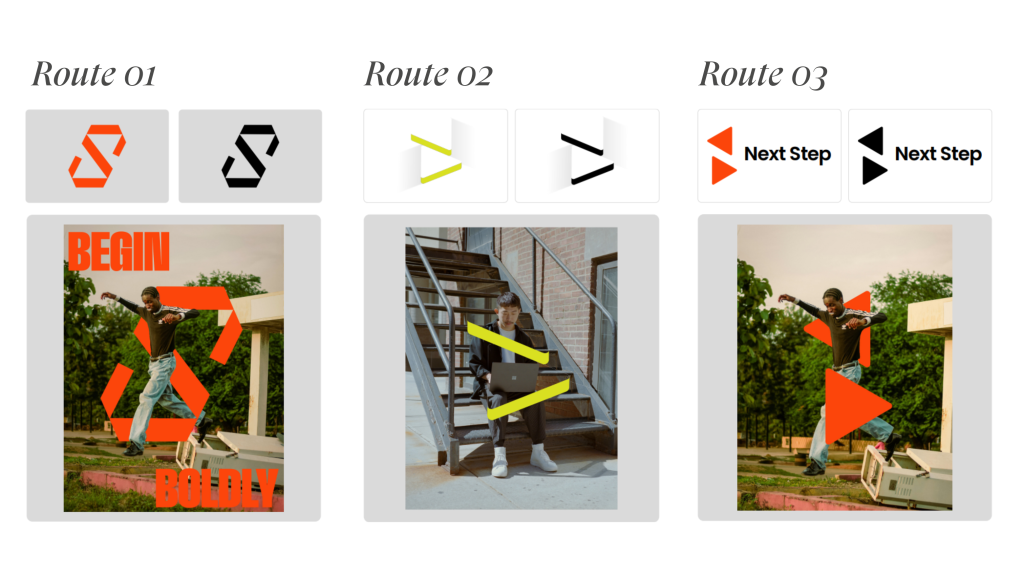
The chosen direction strikes the perfect balance between MBA’s established brand and a fresh, youth-oriented identity. The logo subtly incorporates the triangular motifs used throughout the MBA brand, blending them with a more modern symbol to represent what it stands for.
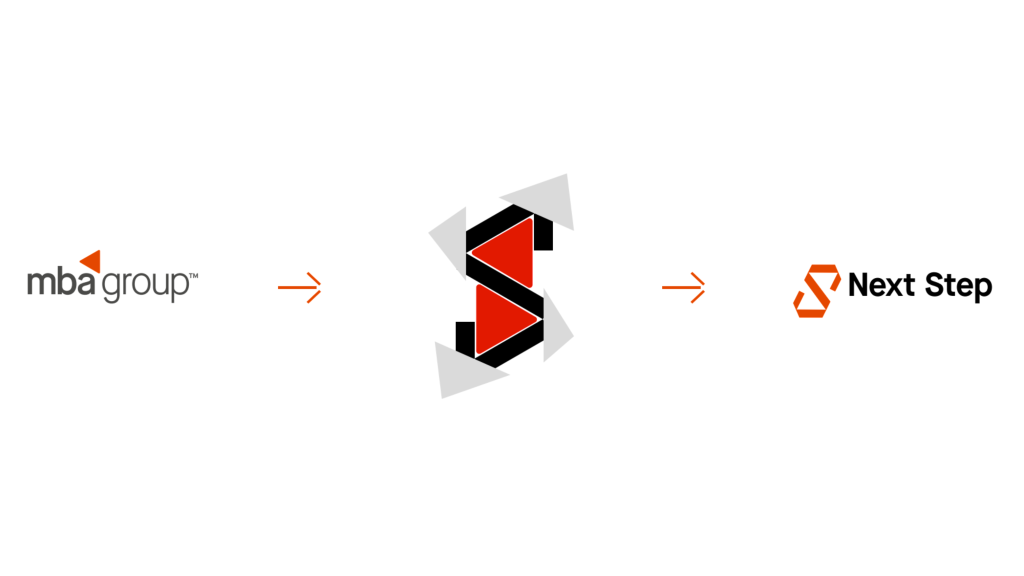
“As an apprentice myself, I was able to draw on my own experiences, which gave me a stronger connection to the work and a clearer sense of direction when making creative choices. This sense of connection made the project feel both meaningful and enjoyable. It wasn’t just about creating something that looked good; it was about designing something that spoke directly to people like me. This gave the project an authenticity that I might not have been able to achieve otherwise.” – Hannah Hall
ㅤ
MBA Brings Next Step to Life
ㅤ
MBA’s leadership team saw something special in Hannah’s work. What started as a university project was a brand concept ready to become a real asset.
The decision was made: Next Step would become the official identity for the apprenticeship programme. A rare moment where a student brief transformed into a live brand.
The first real-world deliverable followed quickly: a physical welcome brochure, designed by Hannah using the identity she’d built from the ground up.
Perfect timing, too. When MBA held its next Apprentice Assessment Day to find the next wave of talent, we had the ideal piece to put in their hands.
ㅤ
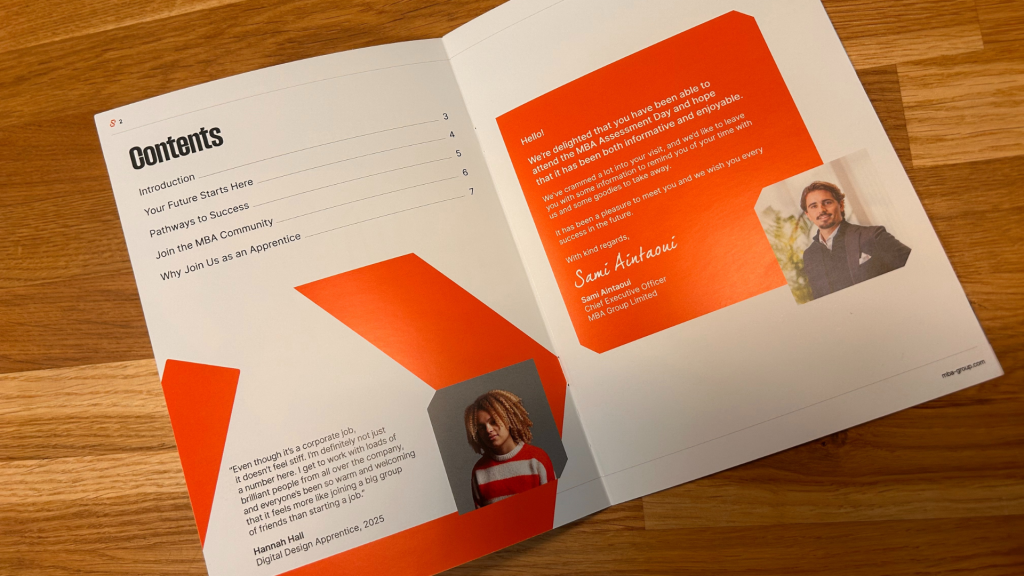
You can view and read the full brochure here.
ㅤ
This is just the beginning for Next Step, but this project represents something bigger: it’s proof of concept for the entire apprenticeship programme. MBA didn’t just hire Hannah to fill a role. We invested in her potential, gave her real responsibility, and watched her deliver work that’s now shaping how we attract and welcome the next generation of talent.
That’s exactly why we run an apprenticeship programme. To find fresh thinking. To nurture raw talent. To give people the space to grow, contribute, and make their mark from day one.
A huge thank you to our Digital Design Apprentice, Hannah Hall, for showing us what’s possible when you give apprentices the platform they deserve!
ㅤ
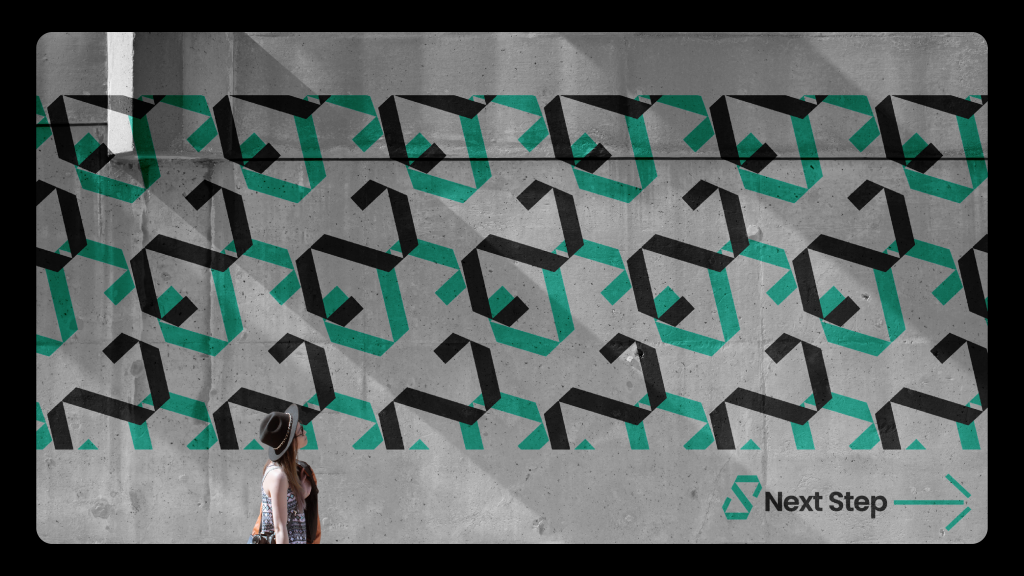
ㅤ
Last week, we opened our doors for MBA’s first-ever AI Week: a packed programme of panel discussions, online sessions and live demonstrations exploring how AI is reshaping the way organisations communicate, create, and connect with customers.
When we first planned AI Week, we wanted it to be a space to unpack the questions, opportunities, and understandable concerns that have surfaced as AI has quickly reshaped the digital world and slipped into the background of so much of our everyday lives. It’s fair to say we achieved that, and more. Each event sparked thoughtful conversations, fresh ideas, and a real sense of momentum around how AI can support smarter, more connected customer experiences.
ㅤ
Four Events. Three Days. One Big Conversation About the Future of Communication.
Event 1: AI & Creativity: Collaboration or Competition?
Hosted by Studio Certain
We opened the week by diving into one of the most debated questions in the creative world: what does generative AI mean for creativity? The conversation covered everything from the risks of misuse to the huge potential for AI to expand what creators can do.
We heard a range of viewpoints, from how PPL are navigating AI’s impact on copyright, licensing, and performer royalties, to Fremantle’s focus on safeguarding originality while still embracing innovation. The session also showcased striking examples of AI-enhanced creative work, including how Studio Certain are using AI to develop complex, brand-attuned visuals that speed up ideation without compromising craft.
“AI is an incredible assistive tool in so many creative endeavours. But what’s really essential is that we have transparency around what creative works have been used in the training of an AI system.” – Camilla Waite, General Counsel, PPL
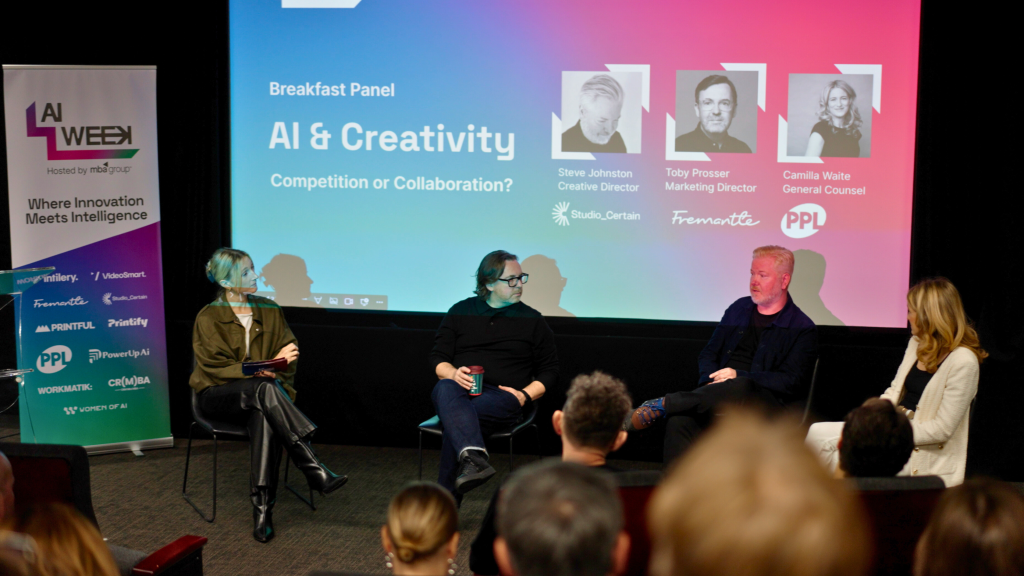
The discussion closed with the big question: is AI competition or collaboration?
Our panel’s answer: it can feel like both, especially in the early stages, but ultimately, AI becomes a collaborative partner when guided by human imagination. Creativity still starts with people; AI just helps push the boundaries.
“I hope people will have more curiosity, more interest, more excitement about what’s happening in the AI space.” – Toby Prosser, Director of Global Marketing, Fremantle
ㅤ
Event 2: How to Build the Best AI Outcomes Through Inclusive Data Science
Hosted by Women of AI
Day two shifted the focus from creativity to people. Cerestrial, an inclusive and sustainable growth leader, led an engaging session on how inclusivity strengthens AI outcomes and why diverse teams are crucial to responsible innovation.
The audience took part in a live AI talent inclusivity audit, which sparked honest discussion about where bias shows up, who gets excluded, and what meaningful representation really looks like in practice.
A standout reminder from the session was this: curiosity drives better AI outcomes than technical skill alone. You don’t need to be a developer to shape how AI functions, you just need the willingness to question, explore, and challenge assumptions.
The panel also highlighted key issues with today’s AI systems: they’re often trained on narrow datasets that don’t reflect the people meant to use them. As our hosts pointed out, diversity isn’t just ‘a good thing to do’, it leads to better business growth. Broader perspectives lead to better insights, more relevant experiences, and can even reduce development time dramatically.
This session encouraged us to look beyond the technology itself and pay closer attention to the people behind it, a perspective that will be influencing MBA’s own AI roadmap going forward.
ㅤ
Event 3: Not Just a Transaction: Using AI to Drive Lasting Loyalty
Hosted by Intilery
Our online session with Intilery brought the conversation back to fundamentals: AI isn’t a magic fix for customer strategy, and it won’t transform customer behaviour on its own.
“I think it’s really important to have that conversation around how AI and customer loyalty comes together to deliver business objectives and to deliver on customer expectations” – Gianfranco Cuzziol, CRM Specialist
A key message from the session was that success with AI in CRM starts with getting the basics right: knowing your customers, understanding their needs, and building experiences that earn trust. Too many organisations jump straight into AI expecting it to ‘do the work’, without the groundwork that makes those tools effective.
We also explored the reality that you don’t need to wait for perfection to start. Small, low-risk experiments can drive valuable early learning, as long as teams understand how to manage risk responsibly.
The panel reinforced that AI should never be used for the sake of it. Its value lies in making things smoother, faster, and more personalised for real people. It’s about enhancing customer experience whilst keeping the human empathy at the heart of strong relationships.
Ultimately, the session reminded us that loyalty isn’t built through technology alone. It comes from consistent experiences that respect the customer, and AI is most powerful when it strengthens, not shortcuts, that connection.
Missed this webinar? You can watch the full session here.
ㅤ
Event 4: Beyond the Algorithm: How Brands Maintain Authenticity in the AI Era
Hosted by VideoSmart
We closed the week with a vibrant discussion on authenticity, and what it means at a time when AI is part of nearly every creative and marketing process.
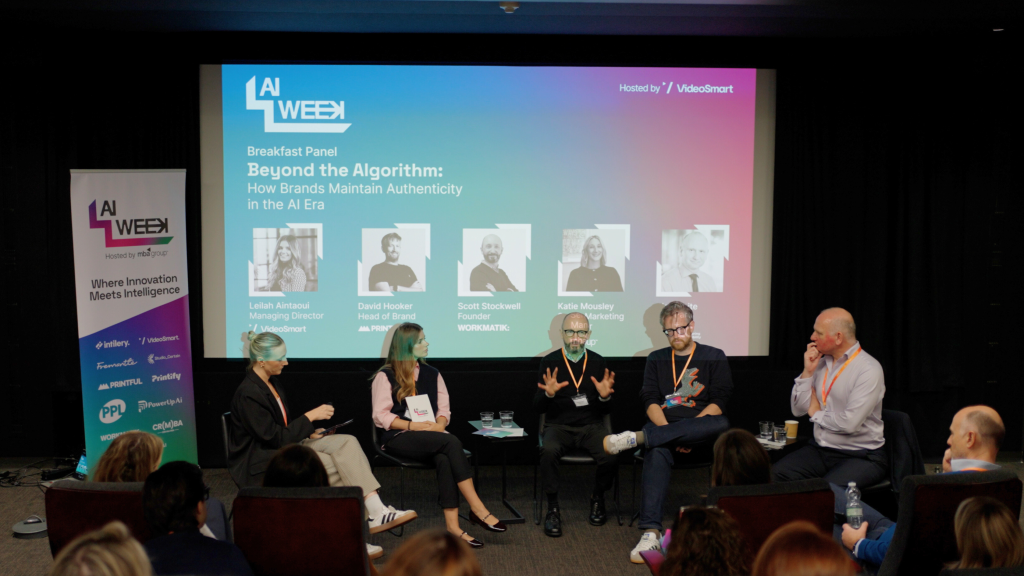
The panel tackled one of the biggest questions brands have right now: how do you keep your message genuine when AI is everywhere? Rather than leaning into the fear or controversy, the discussion encouraged experimentation and openness. As one of our speakers said, “the first pancake is never perfect” but every test teaches you something valuable.
“We haven’t yet unlocked the deeper level of what AI can do, and I think how we do that is by going out and using it to see what we can get from it.” – David Hooker, Head of Brand, Printful
The takeaway was clear: customers care far less about whether something was made with AI, and far more about whether it feels honest, relevant, and emotionally meaningful. Authenticity comes from staying true to your brand values and keeping your audience front and centre.
AI is levelling the creative playing field. You no longer need specialist skills to express an idea visually or conceptually. But even as AI speeds up execution, one principle endures: quality is still quality, regardless of the tools used to make it.
“Don’t be all the gear and no idea. It’s fantastic technology that will give us speed and scale, but take time to understand who you are and what you stand for.” – Scott Stockwell, Founder, Workmatik
ㅤ
Shaping the Future of AI at MBA
AI Week wasn’t just a chance for us to showcase ideas, it helped shape our own direction.
“There’s so much noise and confusion about how AI should be used. When you come together in one space and hear from people about how they’re using it effectively, it gives you that confidence to go away and start doing it.” – Leilah Aintaoui, Digital Growth Director, MBA Group
Across every communication channel, AI is opening new ways for us to streamline processes, enhance personalisation, and support more responsive customer journeys. But the message that resonated across all four events was that AI must be used responsibly, securely, and with people at the core.
As we look ahead, MBA will continue investing in technologies that empower both our clients and our teams. That means:
- Developing responsible, secure AI capabilities
- Enhancing automation across the customer communication lifecycle
- Supporting clients as they adopt AI confidently and compliantly
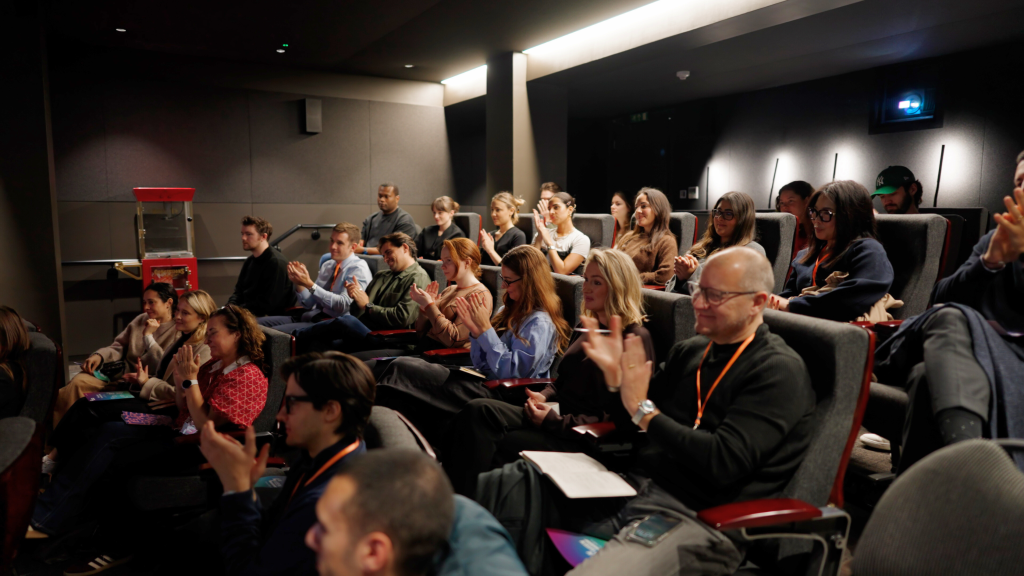
AI Week proved that the future isn’t about choosing between people and technology. It’s about combining the two to create experiences that are smarter, safer, and more meaningful.
We can’t wait to help shape that future for our clients!
ㅤ
This is just the beginning
Unlock our toolkit for actionable AI solutions:
Download Your AI Blueprint: From Hype to Impact
Take the Quiz: Meet Your AI Match
ㅤ
ㅤ
Artificial intelligence is quickly reshaping communications, in how we create, engage, and build trust with audiences.
This November, MBA Group is bringing together the minds leading this transformation for AI Week 2025, a curated series of events exploring the intersection of intelligence and innovation.
Taking place November 10-14 at Hend House, Central London, AI Week offers a rare opportunity to hear from pioneering thinkers and leading brands across creativity, customer engagement, and brand authenticity. Whether you’re navigating AI implementation or questioning its role in your industry, these conversations will challenge assumptions and spark new possibilities.
ㅤ
What’s on?
ㅤ
AI & Creativity: Collaboration or Competition?
Hosted by Studio Certain
Central London
Tuesday 11th November 2025 | 9am – 11am

The creative industries are at a crossroads. As AI tools become increasingly sophisticated, the fundamental questions around originality, authorship, and what makes work truly creative are being rewritten in real time.
This breakfast session brings together Steve Johnston from Studio Certain, Toby Prosser from Fremantle, and Camilla Waite from PPL to explore how AI is transforming culture, from design to entertainment, and what it means for the future of creative work.
ㅤ
Not Just a Transaction: Using AI to Drive Lasting Loyalty
Hosted by Intilery
Online Webinar
Wednesday 12th November 2025 | 3pm – 4pm

Customer engagement is evolving beyond campaigns and touchpoints. This online session examines how artificial intelligence can transform generic interactions into genuine relationships built on trust and personalisation.
Presented by Pooja Jain from PowerUp AI, Tom Anderson from Intilery, Sami Aintaoui from MBA Group, and Gianfranco Cuzziol, the discussion will move beyond surface-level automation to explore how AI can strengthen customer connections in meaningful ways.
“AI enables personalisation at scale, but finding the balance between understanding customer intent and respecting boundaries? That’s still our job as humans,”
says Pooja Jain, highlighting the essential human judgment that must guide AI implementation.
Gianfranco Cuzziol takes this further:
“The line between personalisation and manipulation has never been thinner. AI lets us predict what customers will do next, but predictions aren’t the same as relationships. The real opportunity is to use AI not to speak more, but to listen better. To move from segmentation to understanding, from journeys to meaning.”
The session challenges a fundamental assumption: that loyalty built by algorithms alone can ever truly be loyalty.
As Cuzziol notes, “Loyalty built by algorithms isn’t loyalty at all, it’s a habit.”
ㅤ
Beyond the Algorithm: How Brands Maintain Authenticity in the AI Era
Hosted by VideoSmart
Thursday 13th November 2025 | 9am – 11am
Central London
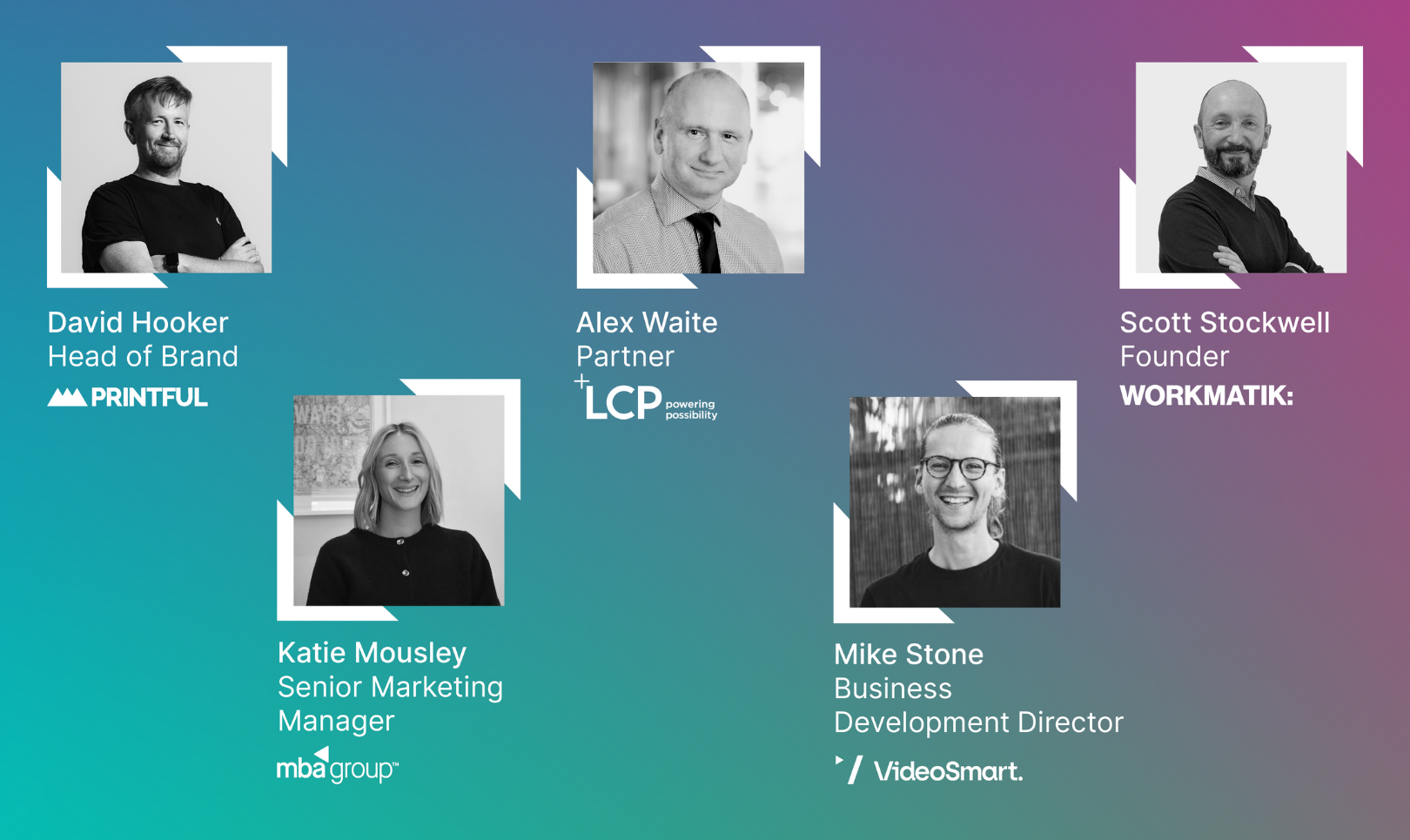
When every brand has access to the same AI tools, what becomes the differentiator? This breakfast panel tackles perhaps the most critical question facing marketers today: how to maintain authenticity, trust, and distinctiveness in an AI-driven world.
Mike S. from VideoSmart, David Hooker from Printful, Alex Waite from LCP, and Scott Stockwell from Workmatik will explore how AI is transforming storytelling, production, and personalisation, and what it takes to stay genuinely connected to audiences.
Scott Stockwell emphasises the foundation:
“Trust is fundamental to building relationships and authenticity is fundamental in building trust. With AI offering unprecedented speed and scale, it’s imperative brands stay true to themselves to build that trust.”
David Hooker reflects on the shifting landscape:
“There’s no longer any excuse for creating boring, difficult to consume content. Every day AI is reducing the skills barrier for anyone who wants to make wow moments. This is in equal parts inspiring, exciting, and terrifying for anyone working in marketing or any creative field.”
ㅤ
Join the Conversation
The questions being asked at AI Week 2025 are the same ones that are keeping marketers, creatives, and business leaders up at night. How do we use AI without losing what makes us human? How do we scale without sacrificing authenticity? How do we innovate without abandoning the principles that built trust in the first place?
These conversations will challenge how you think about AI’s role in your work. They’ll introduce you to peers navigating the same questions. And they’ll equip you with frameworks, insights, and connections to move forward with confidence.
Ready to be part of the conversation? Register for AI Week 2025 today and discover where innovation meets intelligence.

ㅤ
There’s a good chance you’ve seen at least three emails this week about AI tools that promise to transform your business. Perhaps you’ve even tried a few platforms, only to find yourself back at square one, wondering if you’re missing something.
Every week brings another “game-changing” tool in AI, and for marketing leaders and business owners trying to keep up, the paradox is real: the more solutions that emerge, the harder it becomes to know where to actually start.
At MBA Group, we’ve spent decades helping businesses cut through complexity in multichannel marketing communications. And right now, we’re seeing the same familiar pattern that emerges whenever a transformative technology hits the market. Initial excitement. Overwhelming choice. Then paralysis.
We’ve moved from AI hype to AI fatigue, and many businesses haven’t even started yet.
ㅤ
The Human Pushback
Consumers are increasingly sceptical of AI-generated content. Generic LinkedIn posts, formulaic email copy, chatbot responses that miss the point; people can sense when they’re being spoken to by an algorithm. The risk isn’t just inefficiency; it’s eroding trust with audiences who expect authenticity.
So, how do you use AI to stay efficient without losing the humans you’re speaking to?
The brands that are winning aren’t necessarily the ones using AI the most, they’re the ones who are using it strategically, in ways that enhance but don’t replace their company voice.
This raises an uncomfortable question for many businesses: are you using AI because it genuinely solves a problem, or just because you feel you should be?
ㅤ
From Fatigue to Focus
What we’ve learned from conversations with our clients is that the companies making AI work are the ones who have first taken the time to gain clarity about their own goals, constraints, and working styles.
They know where their creative energy is focused. They understand what’s genuinely holding them back, whether that’s budget, expertise, time, or simply having too much on their plates already. They’ve identified the specific business impact they’re chasing.
Armed with that clarity, the overwhelming marketplace of AI tools suddenly becomes navigable. You’re no longer asking “what can AI do?”, you’re asking “which AI approach matches how we work and what we need to achieve?”
ㅤ
Meet Your Match
This is exactly why we created ‘Meet Your AI Match’, a fun and interactive quiz designed to pair you with the strategy that will genuinely make a difference for your business.
It’s a starting point to understand your own relationship with AI before you commit budget, time, or resources. It recognises that a Content Creator’s needs differ from a Customer Service Leader’s, or a Director trying to connect the dots across an entire organisation.
Through just a few questions about your attitude to AI, working style, and business goals, you’ll be paired with an AI personality. Think of it as your horoscope for AI; fun on the surface but grounded in practical outcomes that help you figure out where AI belongs in your business.
Are you the Brand Alchemist, chasing creative breakthroughs and pushing what’s possible without losing the human spark? The Journey Curator, focused on using AI to build smart and personalised customer experiences at scale? Or are you the Strategic Synthesiser, who’s open to all that AI can offer but needs it to ladder up to a clear, cohesive vision across the business.
There’s more personalities waiting to be discovered. Which one matches you? Find out by taking the short quiz below, and you might be surprised by what you learn about your team when they take it too.
ㅤ
Moving Forward
AI fatigue isn’t a sign that AI has failed. It’s a sign that we’ve moved beyond the phase of initial excitement and into something more practical. Businesses are asking better questions now. They’re less interested in what AI can theoretically do, and more interested in what it can practically solve for them.
What’s really holding you back from making progress with AI? What kind of impact are you hoping it will have? How involved do you want to be in managing it? These questions matter because they shape everything that comes after. And if you’re still working out the answers, that’s completely normal.
Maybe it’s worth taking a few minutes to Meet Your Match.

ㅤ
To find out more about our solutions, visit mba-group.com.
ㅤㅤㅤㅤㅤㅤㅤㅤㅤㅤㅤㅤㅤㅤㅤㅤㅤㅤㅤㅤㅤㅤ
Artificial Intelligence is one of the most discussed topics in business today. It dominates headlines, strategy sessions, and investor reports. Business leaders recognise its potential with nine out of ten now considering AI a strategic priority. Yet only a small proportion of organisations have gone beyond conversations and brainstorming, to begin implementing AI in ways that deliver real value to their business.
At MBA Group we’ve done more than explore the idea of AI. We have successfully implemented it across our brands to improve creative development, customer engagement, and operational efficiency. To help other businesses make that same shift from discussion to delivery, we’ve published a new AI Implementation Blueprint, ‘From Hype to Impact’.

This article introduces some of the key themes from our blueprint and sets businesses on the trajectory to implement AI with confidence.
Bridging the Gap Between Interest and Action
While the appetite for AI is growing, implementation is proving to be more complex than many anticipated. According to the Major Players Census 2025, 60% of employees use AI tools at least a few times each week, yet only 15% of them fully understand their organisation’s AI strategy. The result is fragmented experimentation without clear direction.
A growing number of businesses are running pilots and testing tools. However, fewer have established a clear framework to apply AI strategically and responsibly. Our blueprint is designed to help organisations move beyond isolated trials and into structured, scalable initiatives.
A Departmental Approach to AI
Our current approach to implementing effective AI at MBA Group is built around three focus areas where the technology can deliver significant, measurable impact: creativity, customer conversion, and operational performance.
1. Enhancing Creativity
Our creative agency, Studio Certain worked with a financial services client to develop high-quality, on-brand imagery using AI tools. This eliminated the need for extensive photo shoots while maintaining strong visual consistency. The work was delivered faster, at a lower cost, and with greater creative control. For creative teams under pressure to produce more content with fewer resources, AI is helping shift time and focus back to original thinking and storytelling without compromising on quality of work.
2. Supporting Sales and Marketing
With platforms like Vidiu, we’ve helped clients create personalised video content at scale. One UK pension provider now produces targeted, multilingual video for education, sales, and internal training, all powered by AI. These capabilities enable marketing and sales teams to respond to customer behaviour in real time with tailored messages, improving both engagement and conversion.
3. Improving Operational Performance
Dots supported a large enterprise in transitioning from a legacy contact centre system while activating AI capabilities such as call transcription, sentiment analysis, and workflow automation. This gave service teams immediate insight into performance, reduced inefficiencies, and improved customer experience from day one.
A Framework for Responsible, Effective AI
Technology is only one part of the equation. Effective AI implementation also requires a clear framework to ensure ethical use, transparency, and long-term value. That’s why our blueprint is navigated by the AI Compass – a decision-making guide focused on five principles:
- Design AI to support human capability, not replace it
- Embed ethical guardrails early
- Prioritise sustainability in AI development and deployment
- Maintain strong governance and accountability
- Focus on business value and measurable outcomes
These principles help ensure that AI adoption not only delivers results but does so in a way that supports people, culture, and trust.
Taking the First Steps
Many leaders believe AI will transform their organisation. What they often lack is a clear place to start. Our blueprint provides a step-by-step action plan, including:
- How to identify high-impact use cases
- How to select the right tools for creative, marketing, and operational teams
- How to measure success and build internal momentum
- How to ensure governance and alignment across departments
It also includes a checklist for implementation, covering foundation, pilot, scale, and optimisation phases.
Moving From Possibility to Performance
AI is no longer a future consideration. It is already reshaping how we work, connect, and compete. The focus has shifted from adoption to execution, and the challenge businesses are now facing is how to apply AI in ways that truly benefit them.
At MBA Group, we’ve seen firsthand what happens when organisations move beyond experimentation and begin to embed AI across their operations in a way that’s right for them. The benefits are tangible, the tools are ready, and the blueprint is available.
Download the blueprint now and take the first step towards a more intelligent, efficient, and creative future.

ㅤㅤㅤㅤㅤㅤㅤㅤㅤㅤㅤㅤㅤㅤㅤㅤㅤㅤㅤㅤㅤㅤㅤㅤㅤㅤㅤ
A transformative moment for business communications
In July 2025, the Data Use and Access Bill officially received Royal Assent, marking a significant evolution in how organisations across the UK access, manage, and communicate personal data.
After months of debate and refinement, this legislation replaces elements of the previous UK GDPR and Data Protection Act with a more UK-specific framework. While it eases some compliance burdens, it also raises new expectations, particularly in areas like digital verification, data transparency, AI governance, and the powers of the Information Commissioner’s Office (ICO).
For regulated industries like financial services, the stakes are even higher. The intersection of marketing, compliance, and customer data has never been more sensitive, or more full of opportunity.
Done right, the new framework can unlock operations, smarter customer engagement, and greater trust. But to get there, businesses need to act quickly and decisively.
ㅤㅤㅤㅤㅤㅤㅤㅤㅤㅤㅤㅤㅤㅤㅤㅤㅤㅤㅤㅤㅤㅤㅤㅤㅤㅤㅤ
Turning compliance into opportunity
Compliance doesn’t have to be a burden. Instead, it can be a powerful catalyst for transformation and growth.
When compliance is integrated into strategy and technology, it drives innovation, helping you deliver seamless, transparent experiences that differentiate your brand and create long-term value.
Now is the time to review your data processes for compliance and identify areas where you can take advantage of new opportunities to stay ahead of the competition.
With that in mind, we’ve created a 10-step Regulatory Readiness Checklist to help you align your communication strategy and operations with the expectations of the new bill. Each action below is designed to support long-term compliance and achieve better business outcomes.
ㅤㅤㅤㅤㅤㅤㅤㅤㅤㅤㅤㅤㅤㅤㅤㅤㅤㅤㅤㅤㅤㅤㅤㅤㅤㅤㅤ
Regulatory Readiness Checklist: 10 Key Actions to Take
1. Update Data Practices and Security
Now is the time to review how data is collected, stored, shared, and deleted. The bill allows for more flexibility in legitimate interest assessments, but only if appropriate safeguards are in place. Ensure your systems are secure, access is role-based, and audit trails are clear.
ㅤㅤㅤㅤㅤㅤㅤㅤㅤㅤㅤㅤㅤㅤㅤㅤㅤㅤㅤㅤㅤㅤㅤㅤㅤㅤㅤ
2. Ensure Ethical AI Use with Public Accountability
If you’re using AI for decision-making, especially in marketing, credit checks, or risk profiling, you must be able to explain how it works and justify its outcomes. The bill encourages innovation but also mandates transparency. Display clear AI usage policies to your audience, rather than hiding them in terms and conditions, and give users meaningful choices.
ㅤㅤㅤㅤㅤㅤㅤㅤㅤㅤㅤㅤㅤㅤㅤㅤㅤㅤㅤㅤㅤㅤㅤㅤㅤㅤㅤ
3. Modernise ID and Verification for New Standards
With growing focus on digital identity and data access rights, your verification systems must adapt. Ensure consent is clearly captured, credentials are interoperable, and any digital ID processes meet government-backed standards. This is particularly important for financial service providers, where customer security comes before anything.
ㅤㅤㅤㅤㅤㅤㅤㅤㅤㅤㅤㅤㅤㅤㅤㅤㅤㅤㅤㅤㅤㅤㅤㅤㅤㅤㅤ
4. Communicate Transparently with Data Subjects
Customers want clarity, and the law now demands it. Review your privacy notices, T&Cs, and marketing opt-ins. Make sure your communications explain the purpose of data collection and how people can access or delete their data, using plain English across all channels.
ㅤㅤㅤㅤㅤㅤㅤㅤㅤㅤㅤㅤㅤㅤㅤㅤㅤㅤㅤㅤㅤㅤㅤㅤㅤㅤㅤ
5. Enhance Multi-Channel Communication
Regulations now require data subject rights to be supported across all communication channels, whether that’s print, digital, email, in-app, or post. Ensure you’re able to manage opt-outs, DSARs (data subject access requests), and consents consistently across platforms.
ㅤㅤㅤㅤㅤㅤㅤㅤㅤㅤㅤㅤㅤㅤㅤㅤㅤㅤㅤㅤㅤㅤㅤㅤㅤㅤㅤ
6. Educate Employees & Customers on the New Landscape
Legal change is only effective if people understand it. Create internal training programmes to brief teams, especially in marketing, IT, customer service and compliance. Empower customers with clear, simple content about their rights and what the changes mean for them.
ㅤㅤㅤㅤㅤㅤㅤㅤㅤㅤㅤㅤㅤㅤㅤㅤㅤㅤㅤㅤㅤㅤㅤㅤㅤㅤㅤ
7. Adapt to New ICO Powers
The ICO now has enhanced powers to audit, investigate, and enforce. Ignoring this leaves your business exposed. Get ahead by proactively reviewing your data protection impact assessments and working with partners who already operate within strict regulatory frameworks.
ㅤㅤㅤㅤㅤㅤㅤㅤㅤㅤㅤㅤㅤㅤㅤㅤㅤㅤㅤㅤㅤㅤㅤㅤㅤㅤㅤ
8. Collaborate Across Departments
Compliance is no longer just a legal or IT function. Marketing, operations, customer service and finance all play a role. Build cross-functional teams and schedule regular meetings to ensure regulatory considerations are embedded across customer touchpoints, from onboarding to offboarding. Create a shared action plan for regulatory compliance, and ensure teams are aligned between marketing strategies and business risk management.
ㅤㅤㅤㅤㅤㅤㅤㅤㅤㅤㅤㅤㅤㅤㅤㅤㅤㅤㅤㅤㅤㅤㅤㅤㅤㅤㅤ
9. Monitor Additional Regulatory Developments
This bill is part of a broader shift. Stay alert to upcoming guidance from the ICO and sector-specific regulators, including the FCA. What’s considered reasonable and proportionate today may evolve quickly, so it’s essential to monitor regulatory updates on an ongoing basis.
ㅤㅤㅤㅤㅤㅤㅤㅤㅤㅤㅤㅤㅤㅤㅤㅤㅤㅤㅤㅤㅤㅤㅤㅤㅤㅤㅤ
10. Innovate with Lawful Data Use in Mind
Innovation doesn’t need to stall. In fact, by embedding compliance into your design thinking, you create products and campaigns that are both high-performing and trustworthy. Use data responsibly to personalise, optimise, and transform customer experiences, all while executing safely.
ㅤㅤㅤㅤㅤㅤㅤㅤㅤㅤㅤㅤㅤㅤㅤㅤㅤㅤㅤㅤㅤㅤㅤㅤㅤㅤㅤ
How MBA Group can help you stay ahead
At MBA Group, we specialise in executing simply powerful communications that enrich customer experiences across all touchpoints. From print to digital, transactional to marketing, we help you simplify the complex.
Whether you’re responding to new legislation, transforming your customer journeys, or updating your data handling processes, we’ve got the expertise, technology, and infrastructure to support you:
- Rapid Transformation in 3–6 months
- Smart Data Expertise that drives personalisation and compliance
- End-to-End Communication Solutions across digital and physical touchpoints
- Robust Security and Compliance Frameworks purpose-built for regulated industries
ㅤㅤㅤㅤㅤㅤㅤㅤㅤㅤㅤㅤㅤㅤㅤㅤㅤㅤㅤㅤㅤㅤㅤㅤㅤㅤㅤ
We don’t just help you adjust to change, we help you lead it.
ㅤㅤㅤㅤㅤㅤㅤㅤㅤㅤㅤㅤㅤㅤㅤㅤㅤㅤㅤㅤㅤㅤㅤㅤㅤㅤㅤ
Get in touch at contact@mba-group.com.
Castle Water partnered with Orbyt and MBA Group to deliver a secure, multi-channel billing and payment solution. Through seamless integration between Orbyt’s SaaS platform and MBA’s communication infrastructure, the result was a fully automated billing distribution system spanning print, digital, and dynamic chaser notifications.
SPACEEEEEEEEEEEEEEEEEEEEEEEEEEEEEEEEEEEEEEEEEEEEEEEEEEEEEEEEEEEEEEEEEEEEEEEEEEEEEEEEEEEEEEEEEEEEEEEEEEEEEEEEEEEEEEEEEEEEEEEEEEEEEEEEEEEEEEEEEEEEEEEEEEEEEEEEEEEEEEEEEEEEEEEEEEEEEEEEEEEEEEEEEEEEEEEEEEEEEEEEEEEEEEEEEEEEEEEEEEEEEEEEEEEEEEEEEEEEEEEEEEEE
The Challenge
Castle Water, the UK’s largest independent business water retailer, faced the modern utility challenge: customers expecting digital-first experiences while requiring reliable, secure billing across multiple touchpoints. With a diverse customer base spanning large multi-site organisations to SMEs, they needed a solution that could deliver consistency at scale while accelerating payment cycles.
SPACEEEEEEEEEEEEEEEEEEEEEEEEEEEEEEEEEEEEEEEEEEEEEEEEEEEEEEEEEEEEEEEEEEEEEEEEEEEEEEEEEEEEEEEEEEEEEEEEEEEEEEEEEEEEEEEEEEEEEEEEEEEEEEEEEEEEEEEEEEEEEEEEEEEEEEEEEEEEEEEEEEEEEEEEEEEEEEEEEEEEEEEEEEEEEEEEEEEEEEEEEEEEEEEEEE
The Partnership
Castle Water partnered with Orbyt, whose modern SaaS platform offered secure, multi-channel billing and payment capabilities. To ensure seamless delivery across all communication channels, Orbyt integrated with MBA Group, creating an end-to-end solution that automated billing distribution across print and digital channels.
SPACEEEEEEEEEEEEEEEEEEEEEEEEEEEEEEEEEEEEEEEEEEEEEEEEEEEEEEEEEEEEEEEEEEEEEEEEEEEEEEEEEEEEEEEEEEEEEEEEEEEEEEEEEEEEEEEEEEEEEEEEEEEEEEEEEEEEEEEEEEEEEEEEEEEEEEEEEEEEEEEEEEEEEEEEEEEEEEEEEEEEEEEEEEEEEEEEEEEEEEEEEEEEEEEEEE
Onboarding Built for Simplicity
The implementation experience was described by Castle Water as “seamless and effortless.” Through close collaboration and efficient technical integration, Castle Water moved quickly from planning to production. Communication workflows were established with minimal business disruption, enabling immediate improvements in delivery speed and customer reach.
SPACEEEEEEEEEEEEEEEEEEEEEEEEEEEEEEEEEEEEEEEEEEEEEEEEEEEEEEEEEEEEEEEEEEEEEEEEEEEEEEEEEEEEEEEEEEEEEEEEEEEEEEEEEEEEEEEEEEEEEEEEEEEEEEEEEEEEEEEEEEEEEEEEEEEEEEEEEEEEEEEEEEEEEEEEEEEEEEEEEEEEEEEEEEEEEEEEEEEEEEEEEEEEEEEEEE
Transforming the Customer Experience
Intelligent Communication Delivery
Customers now receive bills through their preferred channel automatically, with intelligent fallbacks ensuring messages always reach their destination. Whether email, SMS, RCS, or print, each communication is personalised and optimised for engagement.
Frictionless Payment Experience
The new QR-code enabled “Scan–Pay–Done” experience has transformed how customers interact with their bills. Mobile-first design supporting modern payment methods means fewer clicks and faster settlement.
Behind-the-Scenes Efficiency
Automated, secure data transfer between platforms eliminated manual processes while maintaining full audit trails. The infrastructure scales seamlessly, handling peak volumes without intervention.
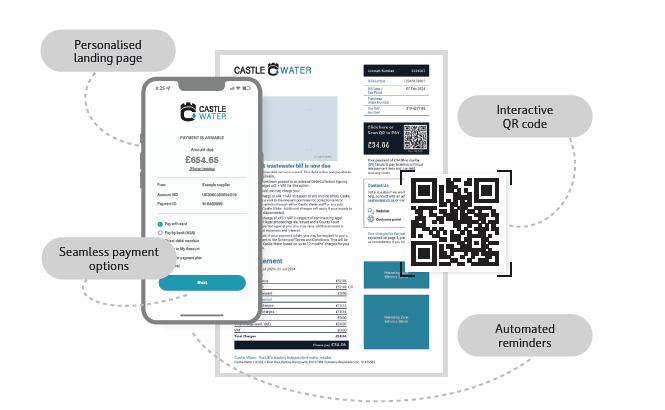
“Reducing DSO is a priority for us, but ensuring a seamless, customer-friendly experience is essential. With Orbyt, customers are paying their bills before the due date.”
David Bain, Digital & Marketing Director, Castle Water
SPACEEEEEEEEEEEEEEEEEEEEEEEEEEEEEEEEEEEEEEEEEEEEEEEEEEEEEEEEEEEEEEEEEEEEEEEEEEEEEEEEEEEEEEEEEEEEEEEEEEEEEEEEEEEEEEEEEEEEEEEEEEEEEEEEEEEEEEEEEEEEEEEEEEEEEEEEEEEEEEEEEEEEEEEEEEEEEEEEEEEEEEEEEEEEEEEEEEEEEEEEEEEEEEEEEE
The Power of Integrated Partnership
The outcomes speak volumes: stronger cash flow, shorter billing cycles, reduced customer queries, and significantly higher engagement across key communication channels.
This collaboration highlights the power of complementary technologies working in harmony. Castle Water achieved faster billing cycles and improved customer satisfaction. Orbyt provided a scalable, fully integrated platform, while MBA Group ensured seamless, automated delivery across all channels. Together, the partnership didn’t just enable digital transformation, it made it effortless, effective, and real.
SPACEEEEEEEEEEEEEEEEEEEEEEEEEEEEEEEEEEEEEEEEEEEEEEEEEEEEEEEEEEEEEEEEEEEEEEEEEEEEEEEEEEEEEEEEEEEEEEEEEEEEEEEEEEEEEEEEEEEEEEEEEEEEEEEEEEEEEEEEEEEEEEEEEEEEEEEEEEEEEEEEEEEEEEEEEEEEEEEEEEEEEEEEEEEEEEEEEEEEEEEEEEEEEEEEEEEEEEEEEEEEEEEEEEEEEEEEEEEEEEEEEEEE
Why Choose MBA for Your Customer Communications?
When customer communications need to work flawlessly across multiple channels, MBA Group delivers the infrastructure and expertise that makes complex integration simple. We don’t just handle your communications—we help you transform how customers experience your business.
Ready to transform your customer communication strategy? Discover how MBA Group can help you deliver seamless, multi-channel experiences that drive results.